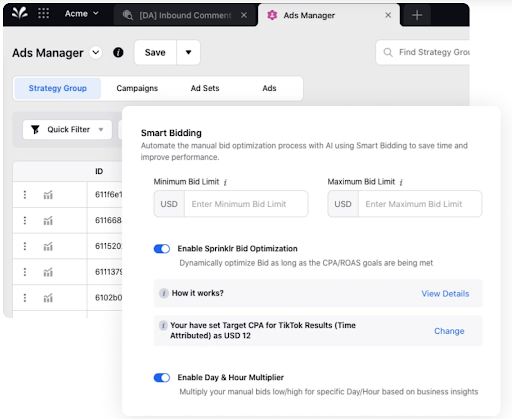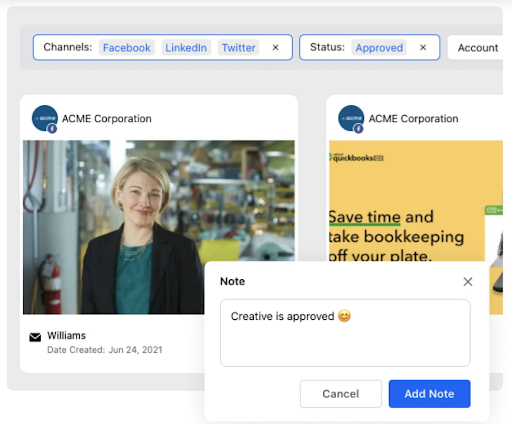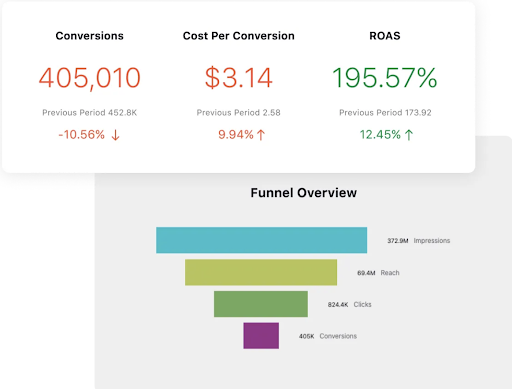What are advertising campaigns?
Advertising campaigns are organized, planned efforts to promote and sell a product or service through various media channels like television, radio, print, online, and outdoor advertising. The goal of an advertising campaign is to reach a large target audience and create brand awareness, drive sales and generate leads.
The success of an advertising campaign is measured by its ability to achieve the desired outcomes, such as increased brand recognition and customer engagement. A well-executed advertising campaign can have a significant impact on a business's bottom line.
Types of advertising campaigns
While there are many different “types” of advertising, the following four categories cover a vast majority of all digital advertisements. Keep in mind that they’re not all mutually exclusive.
1. Display advertising
Display advertising, which is also called “banner” advertising, is a type of advertising that’s composed of small digital billboards or banners that are placed in and around blog posts, keyword search pages, websites, etc. Display ads can be both unmoving images or animated. They usually tend to take on the form of horizontal banners at the top of a page or as vertical banners in the side margins of a page.
Display ads are great for telling a fast visual story while showing off a brand’s identity. They’re usually more visually appealing with very little text.
2. Video advertising
Video ads are quite popular in today’s digital marketing environment, and it makes sense. Video advertisements are eye-catching, entertaining, and great for telling a complex story that a display ad simply cannot. Instream video ads and outstream video ads are the primary kinds that advertisers go with. Instream video involves placing video ads mid-roll, pre-roll, or post-roll in a video that a consumer is already watching. The ad itself will be relevant to the content that the consumer is already watching. On the other hand, an outstream video ad is a video ad that’s integrated into an article or blog post.
3. Mobile advertising
Mobile advertising is quickly becoming the new norm, as more people are consuming online content through their mobile devices than ever before. Simply put, mobile advertising involves ads that are optimized for mobile consumption. Mobile ads are quite broad and can include video, app, display, search, or social ads. For most brands, video-based social media mobile ads are a great place to start.
4. Native advertising
This form of advertising involves simple ad content that’s integrated into a piece of content. They are considered “non-disruptive” ads and usually come in the form of sponsored content. These ads will match the style and flow of the content that they appear in without being pushy or disruptive. For example, pop-up ads and autoplay videos are considered disruptive and can often have a negative impact on one’s potential customer base. Native ads, alternatively, are “slipped” into content in a way that’s not disruptive but more attractive to consumers. They can come in the form of blog posts, videos, photos, etc.
Why are advertising campaigns important?
Advertising campaigns play a crucial role in promoting products or services, building brand awareness and reaching target audiences effectively. Through well-crafted campaigns, businesses can generate interest, drive sales and create a competitive advantage in the marketplace. Effective advertising campaigns also allow companies to stay top-of-mind for potential customers and remain relevant in a rapidly evolving market landscape.
How to create an effective advertising campaign
Make sure your ads are "on strategy" with your business positioning
A good positioning strategy ensures the identification of the correct target audience for your advertising, along with a listing of meaningful features and benefits. It can provide reasons why the product is superior and unique while deriving an advertising "personality."Communicate a simple, single message
People have trouble remembering someone's name, let alone a complicated ad message. Use the "KISS" principle for ad messages: "Keep It Simple, Stupid." The simpler the headline, the better. And every other ad element should support the headline message, whether that message is "price," "selection," "quality," or any other single-minded concept.Follow channel best practices
Every channel has a set of best-practice guidelines that help improve click-through rate (CTR).Be credible
If you say your quality or value is the "best," and it is clearly not, advertising will speed your demise, not increase your business. Identifying and criticizing the competition should also be avoided. It’s potentially confusing and distracting, and it may backfire on you by making buyers more loyal to competitive products, not less.Ask for the sale
Invite buyers to come to your store, send for more information or call for information and orders in the ad. Provide easily visible info in the ad, like location, telephone number, store hours, charge cards accepted, etc., so potential customers can buy more effortlessly.Make sure the ad is competitive
Do your homework. Examine competitive ads in the media that you’re planning to advertise in. Make sure your ad stands out from competitive ads. You can use personal judgment, ad test exposures to a small group of target buyers (i.e., qualitative research) or more expensive, sophisticated quantitative test methods. Compare ads for uniqueness, memorability, credibility, and incentive to purchase.Be truthful
Whatever advertising medium you select, make sure your message is ethical and truthful.
The best advertising campaigns of all time
1. Nike — "Just Do It" campaign
Nike’s “Just Do It” campaign is one of the most iconic marketing campaign examples. Nike launched the campaign in 1988 and featured both professional and amateur athletes sharing their accomplishments and inspiring viewers to reach greater heights themselves. One of the first television advertisements for the campaign featured an 80-year-old marathoner named Walt Stack, a dedicated athlete who runs 17 miles every morning.
After the campaign went live, thousands of people submitted personal stories about times when they decided to take the leap and “just do it,” from quitting their stagnant jobs to losing over a hundred pounds. The line became Nike’s emblematic tagline and continues to represent the brand.
What made this marketing campaign successful?
Nike identified an emotional connection with its audience and connected meaningful stories to its core values, like motivation, inspiration and healthy living. Nike’s decision to integrate the company’s value proposition with an emotionally driven message led to a wildly successful marketing campaign.
Key takeaway for marketers
Outline your value propositions and connect with your audience emotionally so they feel aligned with your brand.
2. Pepsi — "Is Pepsi OK?" campaign
During Super Bowl LIII, Pepsi debuted a television advertisement that people talk about to this day. The “Is Pepsi OK?” commercial featured Golden Globe Award-winner Steve Carell, Grammy Award-nominee Cardi B and Grammy Award-winner Lil Jon in a fun and playful skit. In the ad, a waiter asks, “Is Pepsi OK?” to a diner who orders a Coke and Carell clarifies in his monologue that Pepsi is “more than OK.”
This advertisement plays on the typical scenario where people order a cola, and the waiter assumes that Pepsi is not their top choice. The ad was accompanied by the Pepsi-sponsored half-time show, a “Planet Pepsi” afterparty, limited-edition cans, and the Pepsi Rookie of the Year Award. The iconic brand leveraged America’s most popular sporting event to start a conversation about why Pepsi is better than average.
What made this marketing campaign successful?
The key to the success of Pepsi’s campaign was self-awareness. The marketers tapped into the real scenarios that their customers experience at restaurants when they encounter their product. So, whenever a waiter asks a customer, “Is Pepsi OK?” the customer will inevitably link the statement to the overwhelmingly successful commercial and campaign message.
Key takeaway for marketers
Figure out how your consumers perceive your brand and use it to your advantage in self-aware marketing campaigns.
3. Dove — "Real Beauty" campaign
People want to hear stories that matter, and Dove’s “Real Beauty” campaign delivered a poignant and authentic message that the beauty industry desperately needs. The Dove Campaign for Real Beauty was launched in 2004 by Unilever, aiming to build self-confidence in women and children. The initial campaign featured research and reported that only 2% of women consider themselves beautiful.
The next phase featured a series of billboards starring real women instead of models. The campaign was well-received and expanded into other forms of media, promoting aging, diverse body types, as well as transparency around wigs, blemishes and so-called “imperfections.” The mission of the ads was to redefine beauty and shine a spotlight on how harmful the beauty industry could be to young women.
What made this marketing campaign successful?
The Dove Campaign for Real Beauty was celebrated because it used marketing to positively impact the cultural landscape, industry and lives of consumers. The campaign continues to run today to dismantle the #BeautyBias and help “make beauty a source of confidence, not anxiety.” This campaign has been coupled with change initiatives like “The Dove Self-Esteem Project,” which helps children redefine their definition of beauty.
Key takeaway for marketers
Select a real issue that aligns with your organization’s values and use marketing efforts to impact your community positively.
Execute effective campaigns at scale with Sprinklr
Today’s advertising tech stacks are fragmented and chaotic. As the number of channels expands and cross-platform barriers between point solutions build, converting customers at scale becomes almost impossible. Countless teams are confined to channel-specific social-advertising tools that rely on manual processes, limited integrations and siloed reporting. And because of this, customer and market data is lost in the shuffle, and teams can’t collaborate.
A unified customer experience management (Unified-CXM) platform for social advertising eliminates these barriers. Advertisers and media teams need to plan, execute, analyze, and optimize ads with a centralized and shareable data source for omnichannel and third-party analytics. And when they do, they can transform ad spend into relevant campaigns that drive high-quality conversions.
With Sprinklr, you can:
Increase campaign performance by up to 50%
Create personalized campaigns and ads that deliver better return on ad spend (ROAS) and high performance with Sprinklr’s listening-based creative insights. Optimize your ads based on business KPIs, bids, budgets and creatives — all with a simple click by using Sprinklr’s Strategy Groups. Identify new audiences and remove or suppress irrelevant ones to make a robust targeting strategy with Sprinklr’s audience integrations and insights. Trigger and optimize ads based on sentiment, share of voice, sports, weather and more from a single, unified platform.

Improve productivity by 53% with automated workflows
Improve collaboration on content development, budgets and audience targeting, and bring campaigns to market faster with Sprinklr’s paid brief capabilities and shared creative library. Share automated workflows, established naming conventions and creative and audience templates across global, local and cross-channel teams from one central location. Create and manage all your advertising campaigns from within Sprinklr’s Ads Manager to simplify your tech stack, eliminate point-solution chaos and lower your total cost of ownership.

Minimize global brand risk across 8+ modern channels
Build frameworks to ensure cross-channel, global governance with permission controls for ad accounts, pages and user groups — all from Sprinklr’s Unified-CXM. Prevent off-brand campaigns from going live by ensuring that all of your ads stick to your brand guidelines with Sprinklr’s automated ad and budget approvals. Use Sprinklr’s listening insights to understand how your customers feel about your ads wherever and whenever they appear. Turn off ad activity instantly in response to sudden events or sensitive news cycles with Crisis Switch.
Gain actionable insights and measure performance instantly
Gather and analyze data from more than 30 sources in a single place. Monitor, analyze and optimize every campaign with Sprinklr’s easy-to-read visualizations, which showcase analytics and channel data, like audience behavior, trends, budgeting and pacing. Remove ad-hoc reports from the equation by giving access to Sprinklr’s highly customizable, real-time dashboards to your entire organization.

Frequently Asked Questions
The digital ad market can essentially be segmented by platform into these categories: desktop ad, mobile ad (mobile web and in-app), digital TV and various other platforms. Among these, the desktop ad market accounted for 43.4% of the total digital ad market in 2021, so it was the largest segment. Though, in the future, the digital TV space is expected to be the fastest-growing segment in the digital ad market, when it’s segmented by platform, at a compound annual growth rate (CAGR) of 15.3% through 2021 to 2026.
The global digital ad market hit a value of almost $486 billion in 2021 by growing at a CAGR of 18.5% since 2016. The market’s expected to grow even further from the $486 billion in 2021 to an incredible $980.2 billion by 2026 at a rate of 15.1%. Beyond that, the market’s expected to grow at a CAGR of 12.8% from 2026 to reach a baffling $1793.6 billion by 2031.
Thank you for contacting us.
A Sprinklr representative will be in touch with you shortly.
Contact us today, and we'll create a customized proposal that addresses your unique business needs.
Request a Demo
Welcome Back,
No need to fill out any forms — you're all set.



